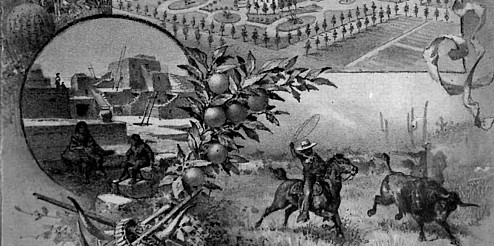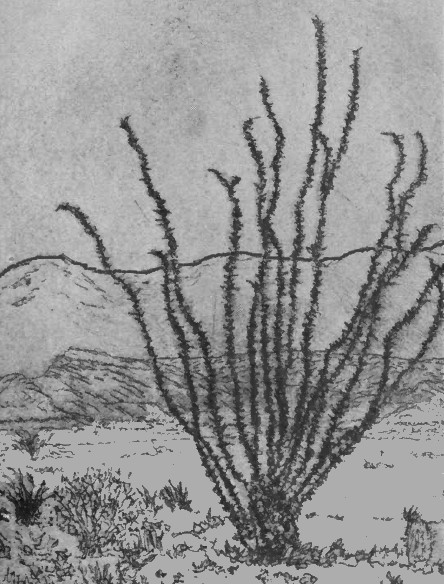TRINITY, YAVAPAI COUNTY
This recently formed district is located on Turkey Creek, some 35 miles
southeast of Prescott. The principal mine is the Tuscumbia which is opened
by shafts, drifts, and tunnels in a thorough manner, and has considerable
high-grade ore exposed on the dump. The company is now constructing a ten
stamp mill at nearby Gus' Springs. The Trinity mine is supposed to
be located on the same vein as the Tuscumbia, at a spot some two miles
northward. The shaft on this mine is down 70 feet. At this depth three feet
of good ore is found. Immediately north on the same vein is also the Sultan,
which is now being opened with good prospects of production, some of its ore
giving high assays. In this vicinity are also located the Keystone, Kendall,
Peerless, Alice, and Imperial, all of which are being opened, and show some
good ore.
TONTO BASIN, GILA
COUNTY
This is a large section of country which has not as yet been regularly
organized into a single district, but it has been prospected to a sufficient
extent to prove that it contains many ledges of good ore and interesting
potential for the prospector. A shaft has been sunk on the Nash mine to the
depth of about seventy feet, disclosing a ledge varying in width from two to
four feet. Two
arastras are in operation on this property, the
gold quartz ore yielding about sixty dollars to the ton. The
Tonto Chief, May-be So, and several other claims, are also being developed
with what seem to be good prospects ahead. This section affords a good
supply of wood and water for mining purposes.
TUMACACORI, PIMA COUNTY
Tumacacori, an old ruined mission, situated in the mountains on the west
side of the Valley of the Santa Cruz, was, like Tubac, the center of
extensive mining operations many years since. All over this section may be
seen the evidences of old mining, and tradition says that near this place
was located the Tumacacori mine of wonderful richness, from which the Jesuit
Fathers, with a trained band of Indian miners, for a long time quietly
extracted immense amounts of silver. A day came at last when the crafty
Apache surrounded the mission, and left not a soul to tell the story of its
destruction, or even to point out the location of its rich mines. A recent
prospector claims to have found this old mine: but whether he has or not,
the search in this rich mineral district, cannot fail to bring to light
other mines perhaps as rich as Tumacacori.
TURKEY CREEK, YAVAPAI COUNTY
This district lies southeast of Prescott, and is bounded on the north by
Big Bug, and on the south by Peck District. The most noted mine in this
section is the Goodwin, discovered in 1864, and named in honor of the person
who was then Governor of the Territory. It has well defined croppings, which
can be traced a distance of several hundred yards. Upon the original
discovery there are two shafts sunk, one sixty and another ninety feet in
depth. In a tunnel run from one of the shafts, it is said ore was found
assaying two hundred dollars a ton ; but work had to be suspended on account
of a heavy flow of water which rushed in at that point. On the Homestead and
Morning Glory ledges, near the Goodwin, very high-grade ore has been
obtained. There are quite a number of other ledges prospecting well, which
when developed will no doubt prove valuable; wood and water are abundant.
TURQUOISE, COCHISE
COUNTY
This district is situated in a small detached range east of the Dragoon
Mountains, about eighteen miles from Tombstone. The mineral veins are found
in a general formation of
limestone. The district received its name from the fact of finding
old
turquoise workings, which have been attributed by some to the
Spanish; while others believe they were worked by the Aztecs, who are known
to have admired this gem. Some of these excavations are two hundred feet in
length, and from ten to sixteen feet in depth. The
silver ores are argentiferous
galena, chlorides and carbonates. About one hundred and fifty
locations have been made; among which may be named, as most prominent, the
Mono, Defiance, Dragoon, Elgin, Contention and Hidden Treasure.
TYNDALL, PIMA COUNTY
This district is situated on the east side of the Santa Cruz Valley,
adjoining the Aztec District, and embraces within its limits the lower
ranges of the Santa Rita Mountains. It is one of the oldest and probably one
of the richest mining sections in Southern Arizona. In every portion of it,
especially at Tubac, the Hacienda del Santa Ritas, and at the mission of
Tumacacori, are to be found the remains of arastras and smelters, together
with large dumps of ore slag, which proclaim this district to have been in
former times the scene of extensive mining operations, in what was then
Northern Mexico. It is at least sixty years since any of these works were
used. The district affords sufficient wood and water for mining and milling
purposes, and in the mountains is found a fine growth of pine timber. Among
the most noted mines are the Mercer's group, owned by T. L. Mercer,
Campbell's group, Neil's group, Megry's group, Josephine group, Black &
Casey's group, Devil's Cache, and the Arnold and Surprise mines.
VULTURE MINE, MARICOPA
COUNTY
This noted gold mine is located in the northwestern portion of the
county, eleven miles east of Seymour. It was discovered in 1863 by Henry
Wickenburg, and worked continuously for several years. Two mills were
erected at the town of Wickenburg for the reduction of the
gold ore, from which a large amount of bullion was extracted.
Through bad management on the part of those in charge, and hostility of the
Apaches, the company were finally forced to suspend operations, and the
property was sold for taxes. It was afterwards re-located, and by
misrepresentations sold to Mr. Seymour of New York for a big price. This
gentleman finding himself victimized, determined to see the speculation
through, and went energetically to work to develop the mine. Water was
carried through a six-inch galvanized pipe from the Hassayampa Creek to the
mine, a distance of fourteen miles, and an eighty-stamp mill erected. These
operations, it is said, cost Mr. Seymour $358,000. When the mill was
started, it worked to a charm, and the daily profit from the working of the
ore amounted to $1000, which, together with the sale of stock, soon
reimbursed Mr. Seymour for the large amount expended, and left him in the
possession of a fortune. The ore vein is an immense ledge of low grade
quartz, which is run through the mill without assorting.
Return
to The Arizona Page:
Arizona Gold Rush Mining History



